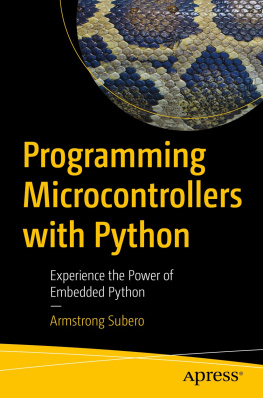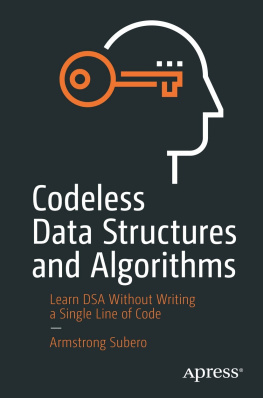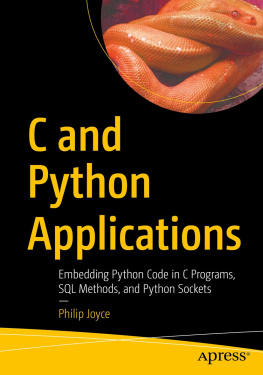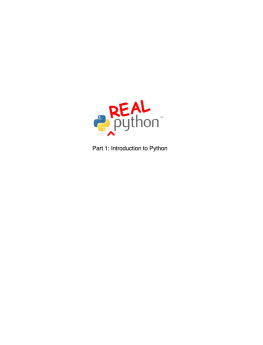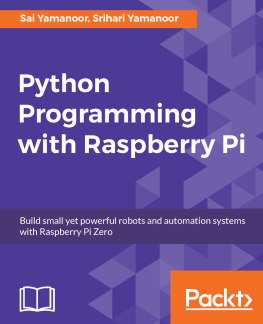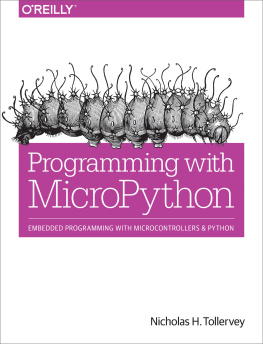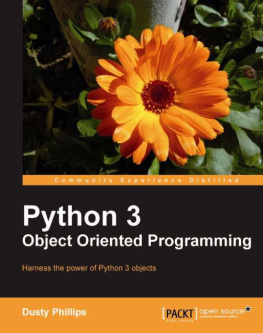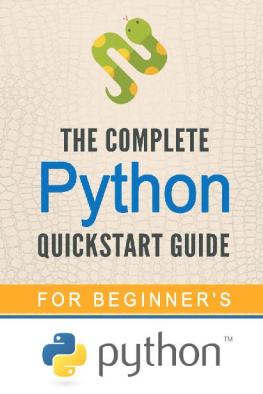Armstrong Subero - Programming Microcontrollers with Python Experience the Power of Embedded Python
Here you can read online Armstrong Subero - Programming Microcontrollers with Python Experience the Power of Embedded Python full text of the book (entire story) in english for free. Download pdf and epub, get meaning, cover and reviews about this ebook. year: 2021, publisher: Apress, genre: Computer. Description of the work, (preface) as well as reviews are available. Best literature library LitArk.com created for fans of good reading and offers a wide selection of genres:
Romance novel
Science fiction
Adventure
Detective
Science
History
Home and family
Prose
Art
Politics
Computer
Non-fiction
Religion
Business
Children
Humor
Choose a favorite category and find really read worthwhile books. Enjoy immersion in the world of imagination, feel the emotions of the characters or learn something new for yourself, make an fascinating discovery.
- Book:Programming Microcontrollers with Python Experience the Power of Embedded Python
- Author:
- Publisher:Apress
- Genre:
- Year:2021
- Rating:4 / 5
- Favourites:Add to favourites
- Your mark:
- 80
- 1
- 2
- 3
- 4
- 5
Programming Microcontrollers with Python Experience the Power of Embedded Python: summary, description and annotation
We offer to read an annotation, description, summary or preface (depends on what the author of the book "Programming Microcontrollers with Python Experience the Power of Embedded Python" wrote himself). If you haven't found the necessary information about the book — write in the comments, we will try to find it.
Programming Microcontrollers with Python Experience the Power of Embedded Python — read online for free the complete book (whole text) full work
Below is the text of the book, divided by pages. System saving the place of the last page read, allows you to conveniently read the book "Programming Microcontrollers with Python Experience the Power of Embedded Python" online for free, without having to search again every time where you left off. Put a bookmark, and you can go to the page where you finished reading at any time.
Font size:
Interval:
Bookmark:


Any source code or other supplementary material referenced by the author in this book is available to readers on GitHub via the books product page, located at www.apress.com/978-1-4842-7057-8 . For more detailed information, please visit http://www.apress.com/source-code .
This Apress imprint is published by the registered company APress Media, LLC part of Springer Nature.
The registered company address is: 1 New York Plaza, New York, NY 10004, U.S.A.
To all those who tinker to keep the world running
I want to thank my family.
I want to thank everyone who ever said anything positive to me or taught me something. I heard it all, and it meant something.
I want to thank God most of all, because without God I wouldnt be able to do any of this.
started learning electronics at the age of 8. One of the happiest memories in his childhood was when he finally figured out how to make a light bulb. It took off from there as he taught himself more advanced topics in electronics, before delving into computer architecture, and eventually discovering the joys of microcontrollers and FPGAs.
He currently works for the Ministry of National Security in his country; writes software; designs circuits, courses, and robots; writes books; and blogs about technology on www.trinirobotics.com in his free time. He is also a contributing author to Free Code Camp and has degrees in Computer Science and Liberal Arts and Sciences from Thomas Edison State University. He is the author of Programming PIC Microcontrollers with XC8 and Codeless Data Structures and Algorithms both published by Apress Media LLC.
is an embedded systems engineer working for an industrial gases company in Buffalo, NY. His interests, deeply rooted in DIY and open source hardware, include developing gadgets that aid behavior modification. He has published two books with his brother, and in his spare time, he likes to contribute to build things that improve quality of life. You can find his project portfolio at http://saiyamanoor.com .
You have decided to learn about microcontrollers using Python. While it would be nice to jump straight into developing cool stuff, there are a few steps you must take to get ready first. If you have experience with software development, you may be accustomed to just opening an editor and typing code right away. However, microcontroller development is a little more involved than that. After all, you will be writing programs for a separate computer, so there is a lot more to set up. A microcontroller development environment consists of not only software but an entire hardware ecosystem that must be understood to unlock all the magic these devices have to offer.
In this chapter, we will look at setting up an environment for development. By the end of the chapter, you will be ready to select a microcontroller board, and youll have the software tools and hardware devices needed to begin your development with CircuitPython. Lets get started!
In our modern world, computers are ubiquitous. They have become smaller, easier to use, and more integrated into our daily lives. A few years ago, to connect to the Internet and check your email, you would have had to sit down at a large desktop device. Today, you can do the same thing with a computer that fits in the palm of your hand and places all the information in the world at your fingertips.
The advancements in technology that brought us smartphones and tablets have given billions of people access to computers. However, these handheld devices arent the only computers that exist. What if I told you that the billions of smartphones in use pale when compared to another kind of computing device that silently surrounds us? In fact, there are probably a half dozen or more of these devices in the room with you right now. These miniature computers are called microcontrollers, or MCUs, and they can be found all around us.
Microcontrollers are small, intelligent, programmable computers that we use to perform tasks that are repetitive or that require some level of intelligent control without the need for human interaction. Microcontroller devices have a fraction of the computing power of a device like your smartphone or tablet, but they have many, many uses. Any device around you that reacts to a button press, displays information, or makes sounds when something is wrong is most likely controlled by a microcontroller. From calculators to TVs to microwaves and dishwashers, almost every household device you can think of contains a microcontroller.
If you are familiar with computers, you are sure to have heard of a central processing unit (CPU) or a microprocessor: the brain behind your computer. A microprocessor lets a computer perform many functions. One day you might use your computer to type a document, the next to stream your favorite movie, and so on. The microprocessor has a lot of supporting circuitry, including memory and input and output chips, that allows it to carry out all these tasks. These are usually part of the motherboard that houses the microprocessor.
Font size:
Interval:
Bookmark:
Similar books «Programming Microcontrollers with Python Experience the Power of Embedded Python»
Look at similar books to Programming Microcontrollers with Python Experience the Power of Embedded Python. We have selected literature similar in name and meaning in the hope of providing readers with more options to find new, interesting, not yet read works.
Discussion, reviews of the book Programming Microcontrollers with Python Experience the Power of Embedded Python and just readers' own opinions. Leave your comments, write what you think about the work, its meaning or the main characters. Specify what exactly you liked and what you didn't like, and why you think so.

